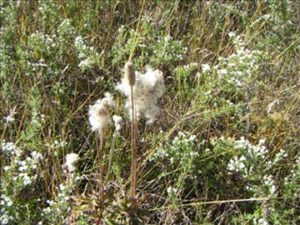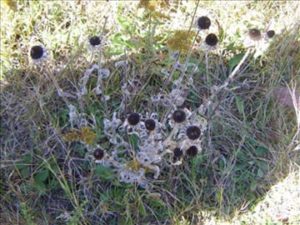Seed Collecting
Seed Collecting and Saving

SEED PODS READY FOR COLLECTING
Photos by: John Oyston
One way to acquire native plants very cheaply is to collect your own seed. This can come from plants you or a neighbour already have, or from plants growing wild in your area.
If you collect wild seeds please bear in mind:
You should get permission from the landowner first. Collecting seeds from plants growing along the roadside is usually OK. In any other location, you need to find out who owns the property and get permission.
You do not want to destroy a native plant colony, or compromise creatures which depend on seeds as a food source. Take no more than 10% of the available seeds. If there are signs that someone else has already collected (trampled grass, stripped or removed seed heads) you should not take any more.
Learn which plants are common and which are rare in your area. Never collect seed from rare species. (plants with status G1 and G2, as ranked globally and sub-nationally in a methodology developed by The Nature Conservancy) except as part of an authorized species recovery program approved by the appropriate government regulatory body. Seed from G3, S1 and S2 status plants should only be collected when they are to be used to establish a regenerating seed source for future seed production and not for direct commercial sale of the wild collected seed itself.
General guidelines for seed collection
Wait until the seed is ripe. Often the seed will become hard, dry and dark in colour. The parent plant may show signs of dying back. Some seeds may have already dispersed.
In some cases, you can pull or shake off the seeds. In other cases its easiest to cut off the seed head and clean it at home later.
Keep seeds dry. Put them in a paper (not plastic) bag or envelope until they are completely cleaned and dried. Once the seeds are cleaned and dry they can be kept in plastic bags, preferably in a dry cool dark place. Remember to label them carefully with the species, the date and the location where they were collected…especially if you plan to donate a portion to NANPS Seed Exchange.
Most seeds mature in the fall and are intended to germinate the following spring. It is often necessary to persuade a dormant seed that it has been through a winter. The exact requirement for each species can be looked up, but the commonest is cold damp stratification. This means moistening the seed and placing it in a cold environment for one or more months before planting.
Growing plants from your own seed is a great way to expand your own garden or to provide extra plants for your friends and neighbours to grow. Careful and responsible collecting of seeds from wild plants can be an important part of regenerating endangered environments such as Tall Grass Prairie. Workshops are available to become a registered Seed Collector. Check with your local Native Plant Society for details.
READ MORE : REAPING WHAT YOU SOW

SEED PODS READY FOR COLLECTING
Photos by: John Oyston










 The 2023 - 2024 Seedex list is available for viewing at Native Plant Seed Exchange!
The NANPS Seed Exchange is open to all members across the continent and relies on your participation. If you are not yet a member, you may join online now or include your membership form with your seed request....
The 2023 - 2024 Seedex list is available for viewing at Native Plant Seed Exchange!
The NANPS Seed Exchange is open to all members across the continent and relies on your participation. If you are not yet a member, you may join online now or include your membership form with your seed request....